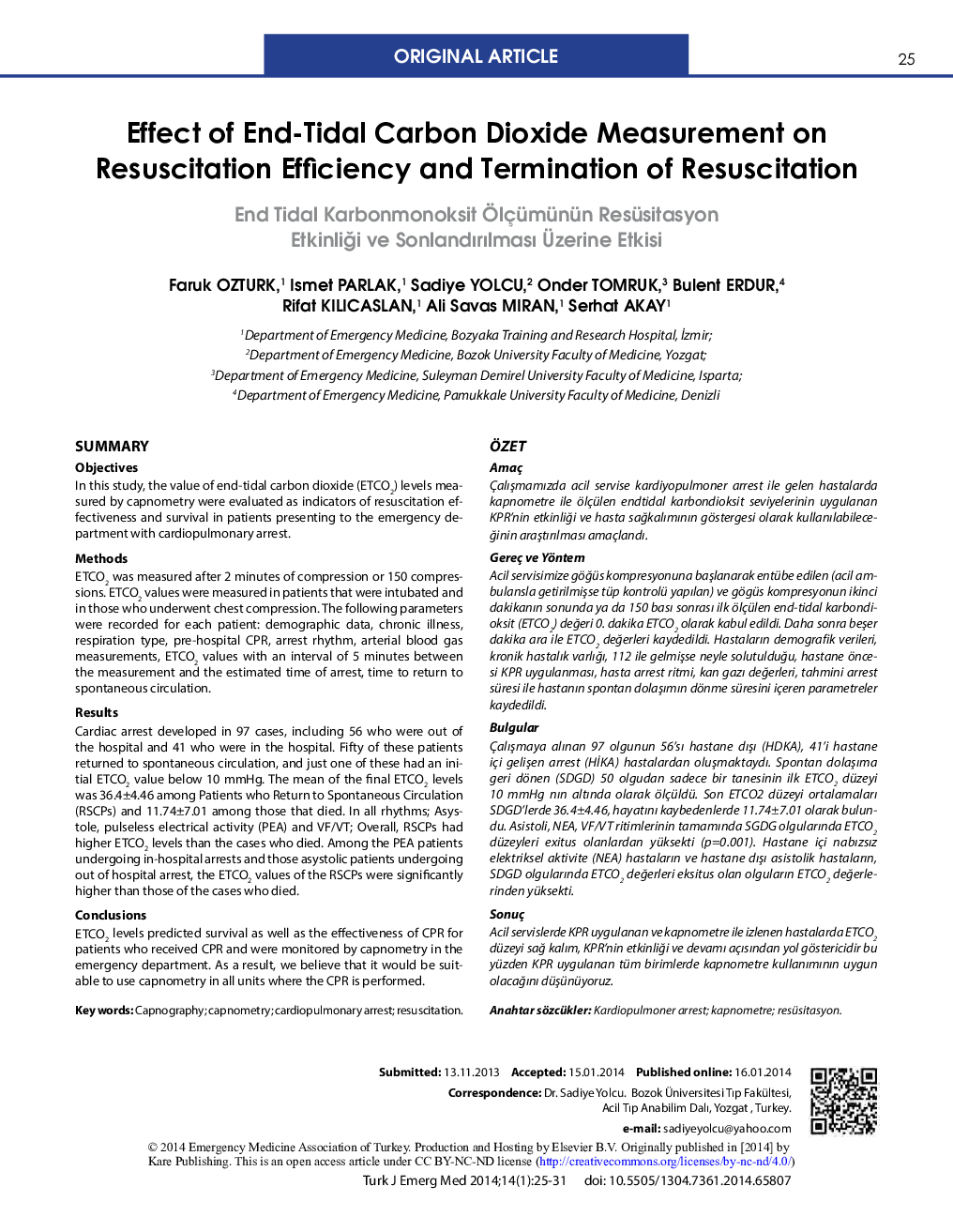| کد مقاله | کد نشریه | سال انتشار | مقاله انگلیسی | نسخه تمام متن |
|---|---|---|---|---|
| 2604187 | 1562738 | 2014 | 7 صفحه PDF | دانلود رایگان |
SUMMARYObjectivesIn this study, the value of end-tidal carbon dioxide (ETCO2) levels measured by capnometry were evaluated as indicators of resuscitation effectiveness and survival in patients presenting to the emergency department with cardiopulmonary arrest.MethodsETCO2 was measured after 2 minutes of compression or 150 compressions. ETCO2 values were measured in patients that were intubated and in those who underwent chest compression. The following parameters were recorded for each patient: demographic data, chronic illness, respiration type, pre-hospital CPR, arrest rhythm, arterial blood gas measurements, ETCO2 values with an interval of 5 minutes between the measurement and the estimated time of arrest, time to return to spontaneous circulation.ResultsCardiac arrest developed in 97 cases, including 56 who were out of the hospital and 41 who were in the hospital. Fifty of these patients returned to spontaneous circulation, and just one of these had an initial ETCO2 value below 10 mmHg. The mean of the final ETCO2 levels was 36.4±4.46 among Patients who Return to Spontaneous Circulation (RSCPs) and 11.74±7.01 among those that died. In all rhythms; Asystole, pulseless electrical activity (PEA) and VF/VT; Overall, RSCPs had higher ETCO2 levels than the cases who died. Among the PEA patients undergoing in-hospital arrests and those asystolic patients undergoing out of hospital arrest, the ETCO2 values of the RSCPs were significantly higher than those of the cases who died.ConclusionsETCO2 levels predicted survival as well as the effectiveness of CPR for patients who received CPR and were monitored by capnometry in the emergency department. As a result, we believe that it would be suitable to use capnometry in all units where the CPR is performed.
ÖZETAmaçÇalışmamızda acil servise kardiyopulmoner arrest ile gelen hastalarda kapnometre ile ölçülen endtidal karbondioksit seviyelerinin uygulanan KPR'nin etkinliği ve hasta sağkalımının göstergesi olarak kullanılabileceğinin araştırılması amaçlandı.Gereç ve YöntemAcil servisimize göğüs kompresyonuna başlanarak entübe edilen (acil ambulansla getirilmişse tüp kontrolü yapılan) ve gögüs kompresyonun ikinci dakikanın sonunda ya da 150 bası sonrası ilk ölçülen end-tidal karbondioksit (ETCO2) değeri 0. dakika ETCO2 olarak kabul edildi. Daha sonra beşer dakika ara ile ETCO2 değerleri kaydedildi. Hastaların demografik verileri, kronik hastalık varlığı, 112 ile gelmişse neyle solutulduğu, hastane öncesi KPR uygulanması, hasta arrest ritmi, kan gazı değerleri, tahmini arrest süresi ile hastanın spontan dolaşımın dönme süresini içeren parametreler kaydedildi.BulgularÇalışmaya alınan 97 olgunun 56'sı hastane dışı (HDKA), 41'i hastane içi gelişen arrest (HIKA) hastalardan oluşmaktaydı. Spontan dolaşıma geri dönen (SDGD) 50 olgudan sadece bir tanesinin ilk ETCO2 düzeyi 10 mmHg nın altında olarak ölçüldü. Son ETCO2 düzeyi ortalamaları SDGD'lerde 36.4±4.46, hayatını kaybedenlerde 11.74±7.01 olarak bulundu. Asistoli, NEA, VF/VT ritimlerinin tamamında SGDG olgularında ETCO2 düzeyleri exitus olanlardan yüksekti (p=0.001). Hastane içi nabızsız elektriksel aktivite (NEA) hastaların ve hastane dışı asistolik hastaların, SDGD olgularında ETCO2 değerleri eksitus olan olguların ETCO2 değerlerinden yüksekti.SonuçAcil servislerde KPR uygulanan ve kapnometre ile izlenen hastalarda ETCO2 düzeyi sağ kalım, KPR'nin etkinliği ve devamı açısından yol göstericidir bu yüzden KPR uygulanan tüm birimlerde kapnometre kullanımının uygun olacağını düşünüyoruz.
Journal: Turkish Journal of Emergency Medicine - Volume 14, Issue 1, March 2014, Pages 25–31
